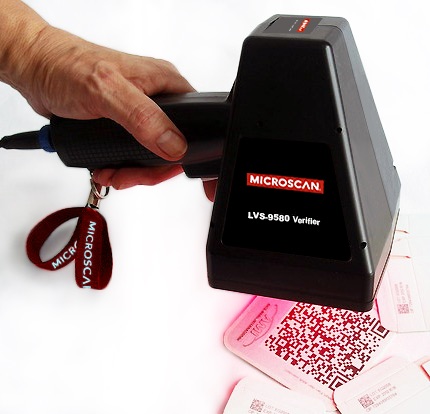In-Line vs. Off-Line Label Inspection
Risk of Off-Line-Only Inspection - by Barbie LaBine, Microscan Systems, Inc.
Customers face fines, supplier disqualification, and damaged reputation when erroneous labels escape into the supply chain. Off-line label spot checking can guarantee the quality of a new label, and can assess the quality of production labels over a given period of time, but do not catch individual errors that may occur during production, such as misprints, printer maintenance problems, debris or foreign matter entering the line, improper movement of goods, or sequential data printing errors. When production errors are discovered using off-line spot checking, entire runs of labels (since the last label that was verified for quality) may need to be inspected and discarded costing time and money. Some customers, however, don’t believe in-line inspection is as reliable as off-line, due to uncontrolled barcode verification conditions during production, so many implement off-line only. Without in-line inspection and barcode verification, however, label production operations are essentially running blind and there is still significant error potential that can lead to serious costs and other negative impacts. This white paper provides information about in-line and off-line inspection and the risks of off-line-only label verification, and also discusses:
- Costs associated with poor-quality labels;
- Common causes of poor-quality labels;
- Implementation of a verification system to eliminate poor-quality labels;
- In-line and off-line inspection systems;
- Advantages of implementing an in-line label inspection system.
The Cost of Noncompliance
|
|
|
Figure 1: Potential labeling problems |
Poor quality labels have the potential to cause huge losses in time and money for a manufacturer. When a shipment of high-quality product is rejected at the customer because of missing or inaccurate product data, a manufacturer stands to lose much more than the potential earnings from the product’s sale. There may also be material costs if products need to be scrapped, or material, shipping, and re-palletizing costs if products need to be returned and reworked. Customers may impose fines on their suppliers to ensure manufacturer compliance or to account for the resources required to handle improperly-labeled product. Or, customers may simply charge back a portion of the manufacturer’s invoice for receiving the noncompliant product. Finally, shipping delays caused by label inspection and re-labeling by the customer can negatively impact revenue and reputation.
Many retailers impose fees per label (for instance, $5 per incorrect label) or per shipment of products (for instance, $200 per shipment). Chargebacks issued to vendors for product label noncompliance can also be incurred for as much as 15% – 20% of the supplier’s invoice, which, for large shipments, can result in losses in the tens of thousands ($10,000 – $20,000 or more) per invoice. With the adoption of globally-regulated standards like GS1 and ISO, the market has observed a new trend in which retailers issue separate fines for label print quality (missing or unreadable product label data) and barcode structure (improperly-structured data per standards such as GS1). There are even greater long-term risks associated with supplying inaccurate labels, such as the deterioration of customer-supplier relations and the possibility of losing supplier status for repeated compliance violations.
The Most Common Causes of Unreadable Barcodes
 |
|
Figure 2: Consequences of poor-quality product labels |

